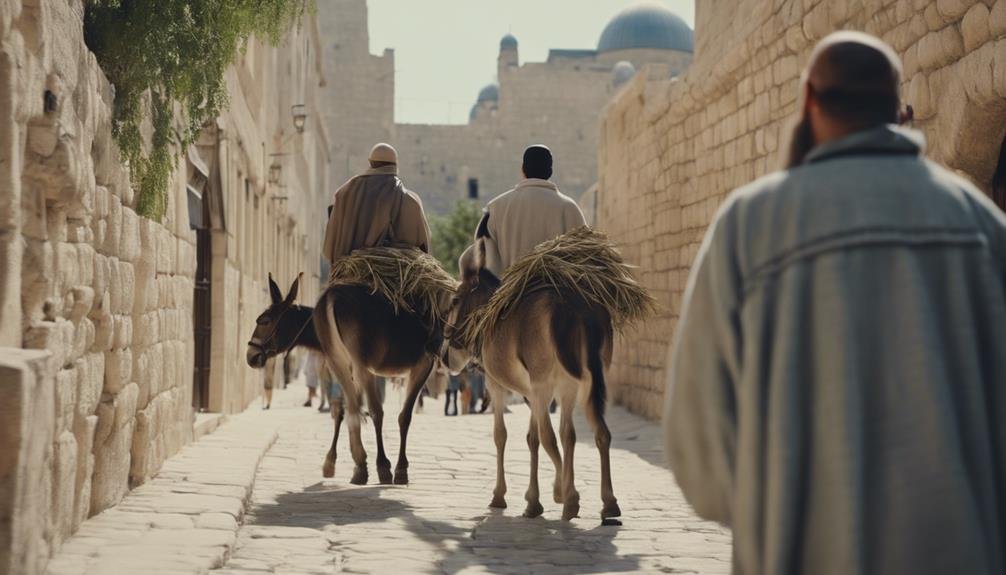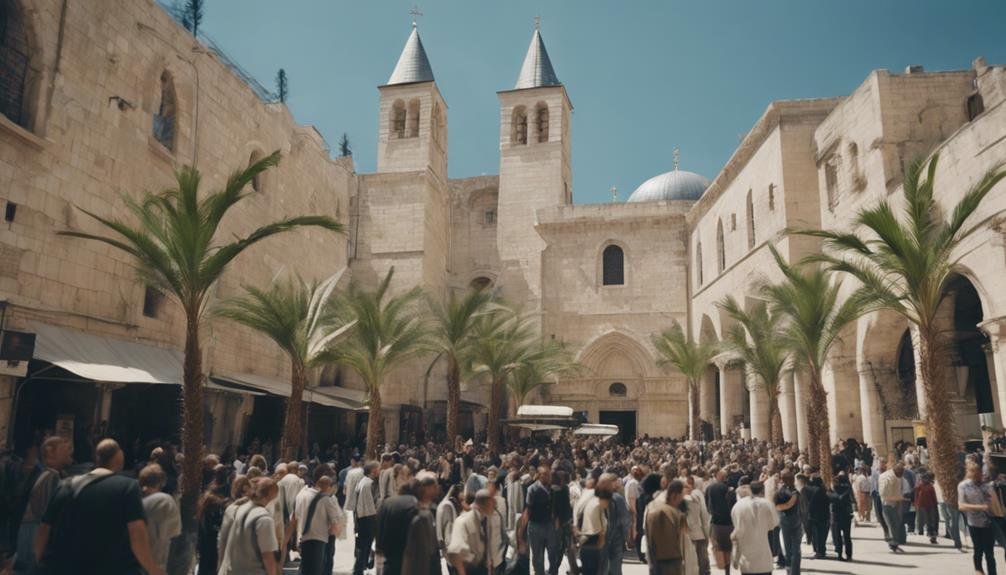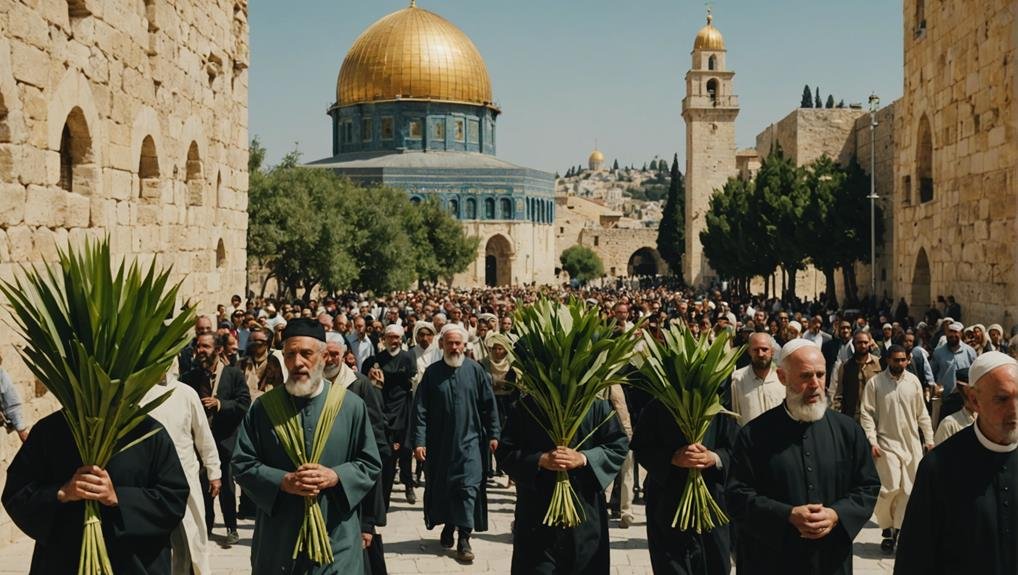As you walk through the bustling streets of Jerusalem on Palm Sunday, you’re transported back to a momentous day over two thousand years ago. This isn’t just any procession; it’s a vivid reenactment of Jesus Christ‘s historic entry into this ancient city.
With each step on the storied cobblestones, from the Mount of Olives to the revered Church of the Holy Sepulchre, you’ll be enveloped by the resonant chants and the poignant sway of palm branches.
But beyond the palpable spirituality and communal joy, have you ever wondered about the deeper layers of tradition and history that fuel this event? What might you uncover about the cultural dynamics that have kept this celebration alive through centuries?
Key Takeaways
- Palm Sunday begins Holy Week with a procession from Mount of Olives.
- Celebrants reenact Jesus’ entry into Jerusalem, often riding donkeys.
- The procession passes through the Old City, featuring hymns and prayers, ending at the Church of the Holy Sepulchre.
- Participants carry olive branches and palm fronds, symbolizing peace and victory.
- This event draws locals and tourists, boosting community engagement and local businesses.
Historical Background of Palm Sunday

Palm Sunday commemorates Jesus Christ’s triumphant entry into Jerusalem, which marks the beginning of Holy Week in Christian tradition. As you explore this historical period, you’ll find that it’s steeped in layers of Roman persecution and the fulfillment of Jewish prophecies.
When Jesus rode into Jerusalem on a donkey, he wasn’t just making a humble gesture. He was fulfilling a prophecy from the Jewish scriptures, specifically one found in Zechariah 9:9, which predicted that a king would arrive in such a manner.
This act resonated deeply with the Jewish community, who saw it as a sign of messianic fulfillment. However, this didn’t sit well with the Roman authorities. The Romans, who controlled Jerusalem at the time, were wary of any potential uprisings.
Jewish hopes for a Messiah who’d overthrow their oppressors were viewed as a direct threat to Roman rule. Jesus’ entry, celebrated by a large crowd waving palm branches—a sign of victory—only heightened these tensions.
You can imagine the charged atmosphere, a mix of hopeful anticipation among Jesus’ followers and cautious surveillance by Roman soldiers. This backdrop of political and spiritual unrest sets the stage for the events that unfold during Holy Week.
Key Traditions and Customs
Against this backdrop of historical tension, Palm Sunday traditions and customs vividly reflect both celebration and deep spiritual reflection. In Jerusalem, you’ll witness a unique blend of solemnity and festivity deeply rooted in the rich tapestry of religious history.
Walking the streets, you’ll likely see faithful holding olive branches, symbolizing peace and victory. These aren’t just any branches; they’re a direct nod to the Gospel narrative, where followers of Jesus greeted him with similar fronds as he entered Jerusalem.
You might also notice the symbolic donkey rides, which reenact Jesus’ humble entry into the city. This custom isn’t merely for show; it’s a profound embodiment of humility and a reminder of Zechariah’s prophetic fulfillment.
Participating in or observing these donkey rides makes you part of a living tradition, connecting you with a pivotal moment in Christian lore. Moreover, chanting hymns and prayers during the processions adds a resonant layer to the observance.
You’re enveloped in a chorus of faith, with each verse and melody drawing deeper lines of connection to the past. These traditions aren’t just observed; they’re experienced and felt deep in the bones of all who gather.
Major Locations for Celebrations

Celebrating Palm Sunday in Jerusalem centers around several pivotal locations, each steeped in historical and spiritual significance. You’ll immerse yourself in this ancient city’s vibrant traditions and deep-rooted history. Here are three major places where the celebrations are particularly notable:
- The Palm Sunday procession traditionally begins on the Mount of Olives. Imagine the scene: you’re walking the same path that, according to Christian beliefs, Jesus took when he entered Jerusalem. The weather conditions here vary, so check the forecast and dress appropriately.
- The Old City: After descending the Mount of Olives, the procession moves into the Old City through the Lion’s Gate. Here, the narrow cobblestone streets echo with hymns and prayers. The air is filled with the aroma of local cuisine from nearby vendors—don’t miss tasting the traditional date ma’amoul or olive bread.
- Church of the Holy Sepulchre: The procession often culminates at this revered site. It’s a profound experience to stand in a place considered the site of Jesus’ crucifixion and burial. The crowd’s devotion is palpable, making it a poignant part of your Palm Sunday in Jerusalem.
Each location offers a unique slice of the city’s spiritual tapestry and bustling culture.
Tips for First-Time Visitors
When visiting Jerusalem for Palm Sunday for the first time, it is important to plan your day meticulously to make the most of this profound experience. Due to its historical and spiritual significance, the city has become a hub of activity with diverse weather conditions. It would be best if you were prepared.
Firstly, weather considerations are key. Spring in Jerusalem can be unpredictable, with possible shifts from cool to warm temperatures throughout the day. Dressing in layers is wise, allowing you to adjust comfortably as the day progresses.
Packing essentials should not be overlooked. Make sure you have comfortable walking shoes, as you’ll likely spend the day on your feet, moving between different sites. A refillable water bottle, sunscreen, and a hat are must-haves to protect against the sun, especially since you’ll be outdoors for extended periods.
Below is a handy table to guide your pack:
| Item | Reason | Note |
|---|---|---|
| Comfortable shoes | Lots of walking | Ideally, worn-in |
| Layers | Variable weather | Include a light jacket |
| Sun protection | Direct exposure outdoors | Sunscreen SPF 30+ |
Cultural Impact and Significance

Now that you’re prepared for the day let’s explore how Palm Sunday has profoundly shaped Jerusalem’s cultural and spiritual landscape.
This significant event isn’t just a marker on the liturgical calendar; it resonates deeply within the community and beyond, influencing various aspects of life in this historic city.
Here are three key impacts:
- Enhancement of Ecumenical Dialogues: Palm Sunday catalyzes unity among different Christian denominations in Jerusalem. Various sects come together on this day, celebrating with shared rituals and processions. This powerful display of unity fosters ongoing ecumenical dialogues, which are essential in a city with diverse religious expressions.
- Influence on Artistic Representations: The imagery of Palm Sunday, from the palm branches to the crowds, has inspired countless artistic representations. These works of art not only adorn the walls of Jerusalem’s churches and public spaces but also capture the spiritual essence of the day, making it accessible to people of all faiths worldwide.
- Community Engagement and Tourism: Each year, locals and tourists flock to Jerusalem to participate in or witness the vibrant Palm Sunday processions. This influx supports local businesses and strengthens community bonds, showcasing Jerusalem’s hospitality and rich cultural tapestry.
These elements highlight how deeply Palm Sunday is ingrained in Jerusalem’s cultural and spiritual fabric, echoing its historical and contemporary significance.
Conclusion
As you explore Palm Sunday in Jerusalem, you’ll be stepping into a living history surrounded by age-old traditions and a jubilant community. Don’t miss the iconic procession from the Mount of Olives and the vibrant scenes in the Old City.
Embrace the local customs, let the solemn chants move you, and absorb the profound cultural significance of this sacred day. It’s an unforgettable experience that will deepen your understanding of the city’s spiritual heart. Make sure to take it all in!
Recommended Articles:
What Are the Best Family-Friendly Sunday Celebrations?
Palm Sunday Prophecy: Symbolism and Significance
Palm Sunday Altar Decorations Inspiring Ideas: Branches of Blessings

